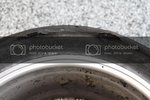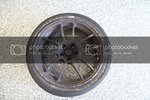- Thread starter
- #21
- Welcome to the Ford Mustang forum built for owners of the Mustang GT350, BOSS 302, GT500, and all other S550, S197, SN95, Fox Body and older Mustangs set up for open track days, road racing, and/or autocross. Join our forum, interact with others, share your build, and help us strengthen this community!
You are using an out of date browser. It may not display this or other websites correctly.
You should upgrade or use an alternative browser.
You should upgrade or use an alternative browser.
Tire Pressure Loss
- Thread starterls110
- Start date
This site may earn a commission from merchant affiliate links, including eBay, Amazon, and others.
More options
Who Replied?John, how are the Enkei wheels holding up with all the flat tires?
- Thread starter
- #23
ls110
John
NFSBOSS said:John, how are the Enkei wheels holding up with all the flat tires?
Rick - The first two blow outs trashed the rim. The third one survived and I will find out early this week if the 4th survived as I dropped it off Friday for mounting. This is one expensive addiction as I dropped off 16 tires and 9 rims. 8 spent tires/wheels, 8 new tires and an extra wheel incase the blow out rim was damaged.
Again I'm not an expert but what I see is the two outside wear markers are almost gone while the middle ones are good. That would suggest pressure to low and the tires is riding or being supported by the side wall. That is what I see unless both of the holes are covered by pick-up.
I would like to see the edge (close up) away from the blown area or from another tire that did not blow. Below is a Rolex tire that was run three track days after being taken off, in fact it is one of the the fronts to the 16 laps tires I sent you. Look at the edges and the strip between the contact patch and sidewall. If you can not see this on yours you are rolling over onto the sidewall. These tires had too much pressure on the third (hot) day. They got to 40-41 and the center wore out a little faster then the sides so I retired them. I could have run them at about 36 PSI to get a few more laps on them but decided to strap on so fresh tires instead.

I would like to see the edge (close up) away from the blown area or from another tire that did not blow. Below is a Rolex tire that was run three track days after being taken off, in fact it is one of the the fronts to the 16 laps tires I sent you. Look at the edges and the strip between the contact patch and sidewall. If you can not see this on yours you are rolling over onto the sidewall. These tires had too much pressure on the third (hot) day. They got to 40-41 and the center wore out a little faster then the sides so I retired them. I could have run them at about 36 PSI to get a few more laps on them but decided to strap on so fresh tires instead.

- Thread starter
- #25
ls110
John
Scott - Your observation is correct that both outer wear markers are basically gone. The strip between the contact patch and the side wall was also gone, but that area of the tire was severely worn after the blow out when riding on the rims. When I dropped off the tires for mounting I did not ask him to retain them so I am out of luck on more photos.
What you are saying about low pressure and the worn outer markers makes sense. While I have been good about inspecting the tires after each session, I think I need to step it up a notch and take more time doing it. I have ordered a temp gauge and will start using that. My son is going with me a week from today, so he and I can take periodic readings across the tire.
My goal next Monday is 36 to 38 hot, much higher than the 30 to 32 I was at. That and the camber change to 2.9 will hopefully solve this problem.
Thank you for all the input as this is very helpful!
What you are saying about low pressure and the worn outer markers makes sense. While I have been good about inspecting the tires after each session, I think I need to step it up a notch and take more time doing it. I have ordered a temp gauge and will start using that. My son is going with me a week from today, so he and I can take periodic readings across the tire.
My goal next Monday is 36 to 38 hot, much higher than the 30 to 32 I was at. That and the camber change to 2.9 will hopefully solve this problem.
Thank you for all the input as this is very helpful!
Sorry you did ask about temps and I forgot to post that. I get temps across fairly even across normally within 10 degrees, sometimes all within 5. I almost always see inside temps the highest when I get clean laps to run hard, no matter if the track is left or right. I do get on occasion the left side tires read the outside edge higher but not by much 3-5 degrees different then the inside.
The middle is normally about 5 degrees or less below the outside edge so it the lowest of the readings.
I have seen temp differences getting to a 15 degree difference, if that was constant or higher, changes would need to be made. Sorry but I do not have a written chart to post since I have not keep good records after using the Orange Electronics TPMS's. I do have one chart that Blacksheep made up but it was a wet track.
FWIW I would shoot for higher pressures 38-40 and work your way down until they give you good grip, even wear without rolling the sides. If you start lower and roll the sides you can not tell if you are doing any good adding the pressure later. Besides IMHO have a few extra pounds is safer then an under inflated tire.
The middle is normally about 5 degrees or less below the outside edge so it the lowest of the readings.
I have seen temp differences getting to a 15 degree difference, if that was constant or higher, changes would need to be made. Sorry but I do not have a written chart to post since I have not keep good records after using the Orange Electronics TPMS's. I do have one chart that Blacksheep made up but it was a wet track.
FWIW I would shoot for higher pressures 38-40 and work your way down until they give you good grip, even wear without rolling the sides. If you start lower and roll the sides you can not tell if you are doing any good adding the pressure later. Besides IMHO have a few extra pounds is safer then an under inflated tire.
- Thread starter
- #27
ls110
John
Thanks for posting those temp ranges. That will be important to know once I start taking the readings.
It kills me to think I am giving up any grip, but you are probably right that I should start high with the pressure and work my way down from there. Point well taken.
It kills me to think I am giving up any grip, but you are probably right that I should start high with the pressure and work my way down from there. Point well taken.
John, any more luck with the blow outs? I was getting some center wear at 36 PSI on the Rolex tires so it looks like they do need a little lower pressure then the CTSCC 275's. I get perfect wear at 39-40 on them (275) no matter the track, flat or banked. I was shooting for 35 on the 285's at HMS and still saw a little more center wear but better then the 36-37 I was running. The setup on the Rolex tires really depends on the track, I need higher pressure at some and lower at others.
- 6,401
- 8,295
I don't know why I didn't see this before, your hot temps are wayyyy too low, probably causing the blow out you describe, camber has something to do with this, (to an extent maybe wheel width as well), but it's not the real culprit. It seems that you can get away with running these tires hot and at higher pressures rather than at low pressure. As far as tire temps go this is what I would recommend:
http://www.longacreracing.com/catalog/item.asp?id=193&catid=7
and:
http://www.longacreracing.com/catalog/item.asp?id=1689&catid=8
But!! you must take the temps as the car comes off the track and have the pressures done at the same time, then start a log book and track the info. There's also temperature compensating and really, the need for nitrogen to keep things in line. Even if you don't do the last 2 things you can still track using temps and pressures but they won't be nearly as accurate or repeatable.
IMO the Hoosier recommendations on pressure loss probably does not apply so much to our tires, keep in mind those are general recommendations and Hoosier still makes extremely soft dirt and bias ply stock car tires, the road race stuff is pretty tight, I monitor the tire pressures across the board, all day, in fact I play this little game where I record the pressures the night before and then next morning, based on temps and humidity I try to "estimate" the tire pressures before measuring them. Every once in awhile I'll have a pressure loss of a pound..maybe, more often than not they're right on.
Also wheel width will also cause heat in some tires if they are too wide/narrow the temp gauge will tell you that right away before it impacts tire wear.
Srsly a tire test may be in order.
http://www.longacreracing.com/catalog/item.asp?id=193&catid=7
and:
http://www.longacreracing.com/catalog/item.asp?id=1689&catid=8
But!! you must take the temps as the car comes off the track and have the pressures done at the same time, then start a log book and track the info. There's also temperature compensating and really, the need for nitrogen to keep things in line. Even if you don't do the last 2 things you can still track using temps and pressures but they won't be nearly as accurate or repeatable.
IMO the Hoosier recommendations on pressure loss probably does not apply so much to our tires, keep in mind those are general recommendations and Hoosier still makes extremely soft dirt and bias ply stock car tires, the road race stuff is pretty tight, I monitor the tire pressures across the board, all day, in fact I play this little game where I record the pressures the night before and then next morning, based on temps and humidity I try to "estimate" the tire pressures before measuring them. Every once in awhile I'll have a pressure loss of a pound..maybe, more often than not they're right on.
Also wheel width will also cause heat in some tires if they are too wide/narrow the temp gauge will tell you that right away before it impacts tire wear.
Srsly a tire test may be in order.
- Thread starter
- #30
ls110
John
Guys - I actually survived an event without a blown tire last Monday. However, I changed tires mid day as I wanted to compare the Conti takeoffs to a new set of Hoosiers. The jury is still out on that comparison. Regarding tire wear, there was a very slight added wear to the inside edge on both left and rights. I was running 38 hot and my camber was reduced to 2.9 from 3.4. The temps were running within 10 degrees across the tire, mid area being about 5 less. The real test will be next Monday when I am running both sets of tires again and thus will have over an hour on both which is when I have typically had failures.
The heat sensor I bought was infrared, and after reading on the web site you provided, they are recommending the probe for tire pressure. That is a spendy probe, but compared to what I have spent this summer on tires and replacing 2 damaged rims, I guess that is not so bad. The pressure gauge is also a step up from what I have been using and also probably worth it.
I have thought about the nitrogen, and unfortunately my guy that does my mounting does not have it. Plus then trying to keep enough spare nitrogen at the track. I do bring a portable tank with me and top it off before each event, so that would be one more item to deal.
The heat sensor I bought was infrared, and after reading on the web site you provided, they are recommending the probe for tire pressure. That is a spendy probe, but compared to what I have spent this summer on tires and replacing 2 damaged rims, I guess that is not so bad. The pressure gauge is also a step up from what I have been using and also probably worth it.
I have thought about the nitrogen, and unfortunately my guy that does my mounting does not have it. Plus then trying to keep enough spare nitrogen at the track. I do bring a portable tank with me and top it off before each event, so that would be one more item to deal.
Good info as always Rob. I do the same thing checking pressures the day before, in the shop out of the sun and then next morning at the track before sunrise after I unload. Most tires keep the correct pressure but a few of them lose a pound or two. I have only had one lose several pounds over night and did not run it.
The pressures you set on the rears at PBIR for me worked well and I have used the same pressure at DIS. Sebring and HMS are where I have seen the center wear and needed to lowered the pressure two or thress pounds at temp.
The pressures you set on the rears at PBIR for me worked well and I have used the same pressure at DIS. Sebring and HMS are where I have seen the center wear and needed to lowered the pressure two or thress pounds at temp.
- Thread starter
- #32
ls110
John
Scott & Rob - It sounds like both of you are determining tire pressure based on wear and temps. How are you bringing grip into the equation? I have clearly been going with too low of pressures trying to maximize grip.
LS110 said:Guys - I actually survived an event without a blown tire last Monday.
That is good news John, it's a start. The temps sound great, hopefully Rob can give you some insight on the inside wear. I see that but normally only on banked tracks. It has never been enough to cause concern and I even forgot to bring it up when the car was balanced.
I also use a non-contact laser reader and see the real racers use the contact type. I know it's better just not sure it is worth it for track day stuff. Same with nitrogen, I have gotten pretty good at adjusting with humid air so not worth the hassle.
LS110 said:Scott & Rob - It sounds like both of you are determining tire pressure based on wear and temps. How are you bringing grip into the equation? I have clearly been going with too low of pressures trying to maximize grip.
I really do not consider that John. I look for even wear across the tires as the priority. I figure grip would be best when you accomplish this. I can tell you the Grand Am teams add a little pressure for qualifying since it is only a few laps. Then they re-adjust (lower) for the actual race.
- 6,401
- 8,295
If you have even temperatures across the tire face, the grip will come, don't take that to the extreme however, the inside will always have a slightly higher temp due to camber, so it should increase as it goes across the face of the tire, if the two inside temperatures are close, it would suggest a high pressure, and thus, the opposite would also be true. More left turns would also show an increase..etc..etc..etc. But ALWAYS relate temps with pressures..and log it.Scott & Rob - It sounds like both of you are determining tire pressure based on wear and temps. How are you bringing grip into the equation? I have clearly been going with too low of pressures trying to maximize grip.
I also use a non-contact laser reader and see the real racers use the contact type. I know it's better just not sure it is worth it for track day stuff. Same with nitrogen, I have gotten pretty good at adjusting with humid air so not worth the hassle.
The probe is the way to go the lasers are notoriously inaccurate, but I still use them to measure track temp and to back up my probe numbers ( but they vary greatly). If you use just air, try to use the same compressor air all the time, bleed out the air that the installer used and use the stuff out of your compressor..all the time, even in your air tank, not as good as nitrogen but better than nothing.Scott's numbers should be fairly valid, not all of them were on a damp track. It's kind of my policy not to post a guy's numbers, that's up to them if they want to share.
Good info as always Rob. I do the same thing checking pressures the day before, in the shop out of the sun and then next morning at the track before sunrise after I unload. Most tires keep the correct pressure but a few of them lose a pound or two. I have only had one lose several pounds over night and did not run it.
are you checking the pressures compared to the temps night vs day?
The best engineer I worked with so far would hand me numbers down to the tenth, the car would come in and all the temps in all four tires would be withing a pound, the guy was awesome.
You have to be careful using just pressures to adjust handling, it's done all the time, but not always successfully, there's a word(s) for this... "demon tweeks"
- Thread starter
- #36
ls110
John
blacksheep-1 said:If you have even pressures across the tire face, the grip will come, don't take that to the extreme however, the inside will always have a slightly higher temp due to camber, so it should increase as it goes across the face of the tire, if the two inside pressures are close, it would suggest a high pressure, and thus, the opposite would also be true. More left turns would also show an increase..etc..etc..etc. But ALWAYS relate temps with pressures..and log it.
Rob - I re-read your comment above and having trouble understanding it. Did you mean to say "temps" in a couple of spots instead of "pressure"?
- 6,401
- 8,295
LS110 said:Rob - I re-read your comment above and having trouble understanding it. Did you mean to say "temps" in a couple of spots instead of "pressure"?
Yes , the word should have been "temps" I fixed and highlighted it in the original post, sorry about that, hopefully that clears it up for you.
- Thread starter
- #38
ls110
John
blacksheep-1 said:Yes , the word should have been "temps" I fixed and highlighted it in the original post, sorry about that, hopefully that clears it up for you.
That makes sense now, thanks. So when you say even temps, and not to extreme, is even getting that within 10 degrees across the tire face, or less than that? I did order the temp probe device you recommended. Now all I need is a pit crew to measure it when I come in hot.
- 6,401
- 8,295
That makes sense now, thanks. So when you say even temps, and not to extreme, is even getting that within 10 degrees across the tire face, or less than that? I did order the temp probe device you recommended. Now all I need is a pit crew to measure it when I come in hot.
As an example...... 30 minute session
Random numbers from a non specific Boss 302 ( sorry all you're getting
LF 199-198-183 RF 171-163-167
C-29 H-45 C-31 H-42
LR 184-185-189 RR 171-175-163
C-25 H-39 C-27 H-37.5
This would show a car with predominately right hand turns
The front pressures are a little high but not outrageously so but the LF needs attention.
LR looks good..perfect actually.
RR probably needs to drop a little, because the center temp is higher than the other two..but over all the pressure is a little low, not horribly so, kind of on the fence here. Might even leave it alone and address the fronts and see what happens.
RF looks like it could use a pound of two but it has the opposite problem for the RR, needs air, but overall pressure is a little too high.
Depending on how long the session last, pull 3 psi out of the LF and add 1psi to the RF and RR and recheck hot.
Now you could stiffen the rear bar, and all of this might go away, but the car was pretty neutral. Hmm maybe stiffen the compression and soften the decompression on the rt, but I'd be real careful there, you could screw yourself right out of the setup, especially on the left hand turns. That's really the engineer's call on the shocks and bar, but this is a classic tire temp/pressure dilemma.
- Thread starter
- #40
ls110
John
Rob - Seeing those numbers is very helpful. Thanks for posting that as it gives me a great reference point to work from.
Similar threads
- Replies
- 2
- Views
- 1K

















